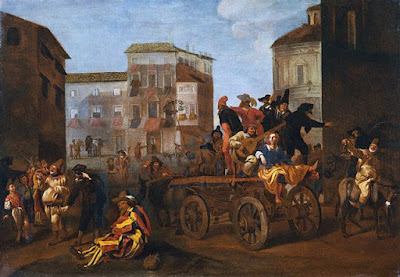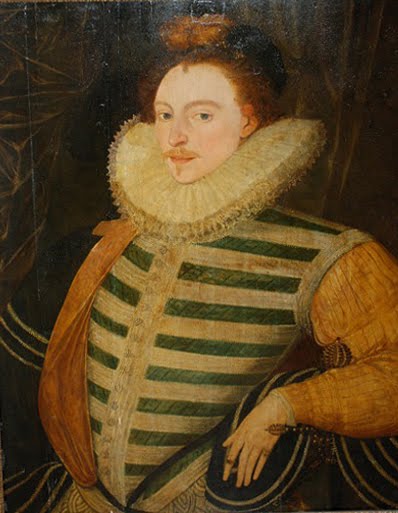Protestants and Catholics
England around 1550 was a country torn between Protestants and Catholics. King Henry VIII had cut the ties with the Catholic church and the Vatican in order to marry Anne Boleyn. The Vatican was at this time not only a religious power, but a strong military power as well. It had a powerful supporter in the Spanish Crown, which at that time ruled over vast sections of Western Europe. Challenging the Vatican meant challenging the supreme power in Europe.
 |
| Edward VI, son of Henry VIII |
Henry VIII's young son Edward become king of England at the age of nine, after the death of his father. Edward was brought up a Protestant and continued his father's pursuit to make the English a Protestant people. However, Edward became seriously ill only six years into his reign. In order to keep the country Protestant, Edward named as his heir his first cousin once removed, the sixteen year old Lady Jane Grey, and excluded both of his half-sisters, Mary and Elizabeth, from the succession.
 |
| Lady Jane Grey, 1537 - 1554 |
The decision was disputed, Lady Jane Grey was desposed, and Mary was proclaimed Queen in 1553. Lady Jane Grey, then aged 17, and her husband, Lord Guildford Dudley, were both executed in February the following year.
 |
| Mary I, 1554 |
Mary I restored the Roman Catholic faith in England, and directly went after Protestant religious reformers. This is why we sometimes know her as Bloody Mary. More than 800 prominent Protestants fled to the continent, among them Catherine Willoughby and her husband Richard Bertie. These two were parents of Peregine Bertie, who would later marry Edward De Vere's sister Mary. Another 283 religious dissenters were burnt at stake during the following years - one can safely assume that the country must have been in a state of chock and disbelief.
Once away from England, a group of Protestant refugees whom had settled in Germany and Switzerland, translated and edited what was to become known as the Geneva Bible. It was a very important translation, and it is thought to have influenced Shakespeare significantly in his writings.
Interesting and significant to note is that the Folger Library in Washington DC, one of the richest collections of Shakespearean documentation today, has one of the few surviving copies of the Geneva Bible. This very copy was once owned by Edward De Vere, 17th Earl of Oxford, and it contains many annotations seemingly corresponding to Shakespeare's plays...
 |
Catherine Willoughby, Duchess of Suffolk, fleeing Catholic England
with her husband Richard Bertie, her daughter Susan and a wetnurse. |
When Queen Mary married Philip of Spain, son of the Habsburg Emperor Charles I in 1554, England was pushed closer to the Vatican and its allies. Philip spent most of his time abroad and the couple never had any children. Mary died, 42 years old in London in November 1558. Her sister Elizabeth became the new Queen and one of the longest serving monarchs in English history.
 |
| Elizabeth I, at her coronation 1558 |
Under Queen Elizabeth's rule, the Church of England finally found its form. England was to remain a Protestant country, despite efforts of the Vatican and Spain to undermine the English sovereignty. Part of the nobility were still Catholics, but the majority now confessed themselves as Protestant.
Back-waters of Europe
 |
| From left; Petrarch, Bocaccio and Dante Alighieri |
As much of Northern Europe, England was at this time still lingering in a partly Medieval world. In Italy however, the Renaissance, the era that would forever transform Europe, had been going strong since the 14th century. Writers such as Dante Alighieri, Giovanni Boccaccio and Francesco Petrarca (Petrach) had begun what seemed to be a revolution. In the Middle Ages, poetry had been written in Latin for an educated and wealthy audience. Dante Alighieri started using the Tuscan popular dialect in written form, which was then a novelty. His
Divina Commedia is still considered one of the world's literary masterpieces. Boccaccio followed with
Decameron, written with realistic dialogue, something completely new. Petrarch was one of the pioneers of the
sonnet form.
 |
| A troupe of actors - Commedia dell'Arte |
Art and theatre flourished during the Renaissance. In Italy, Commedia dell'Arte became the big novelty. Professional actors portraying stock characters such as Harlequin, Pulcinella, Pantalone and Isabella on mobile stages made this new theatre accessible to the public in a way that had not been seen before. Some of the theatre troupes, such as
Compagnia dei Comici Gelosi, reached notable fame and performed for the highest social circles both in Italy and in France.
 |
| Isabella Andreini, actress, 1562 - 1604 |
The actors of Commedia dell'Arte became famous, something that was also a novelty. One actress, Isabella Andreini, even gave name to the stock character 'Isabella' - the female lover, generally portrayed as headstrong, sensuous, and articulate.
 |
Drawings by Inigo Jones.
Left 'Oberon', to the right Susan De Vere, as “Tomyris” in The Masque of Queenes. |
In England during this time, so called
Masques, which included music, dancing and singing, were performed at court. Many of the dancers were courtiers, as seen on the drawings above - the female dancer is none other than Susan De Vere, Edward's youngest daughter. The artist happens to be
Inigo Jones, famous architect and painter and collaborator of Ben Jonson. Inigo was also the original architect of London's Covent Garden, where the church of St. Paul still stands today.
Italian companies of puppet theatre occasionally toured the English provinces, but apart from that, not much theatre reached audiences outside the noble houses and the court. But sometime in late 1570's, things were going to change, when the 'new' theatre was being brought to London...













